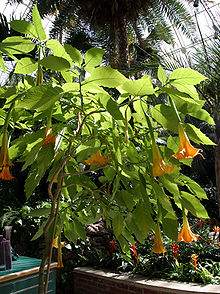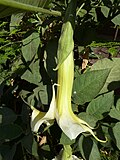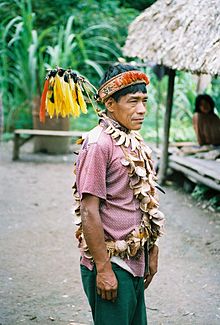Make America Italian Again Ladf Factory
| Brugmansia | |
|---|---|
 | |
| Brugmansia 'Feingold' | |
| Scientific classification | |
| Kingdom: | Plantae |
| Clade: | Tracheophytes |
| Clade: | Angiosperms |
| Clade: | Eudicots |
| Clade: | Asterids |
| Order: | Solanales |
| Family: | Solanaceae |
| Subfamily: | Solanoideae |
| Tribe: | Datureae |
| Genus: | Brugmansia Pers. |
| Species | |
| See text | |
| Synonyms | |
| Methysticodendron R.E.Schult. | |
Brugmansia is a genus of seven species of flowering plants in the nightshade family Solanaceae.[ii] They are woody trees or shrubs, with pendulous flowers, and take no spines on their fruit. Their large, fragrant flowers give them their mutual name of angel's trumpets, a name sometimes used for the closely related genus Datura.
Brugmansia species are amongst the most toxic of ornamental plants, containing tropane alkaloids of the blazon also responsible for the toxicity and deliriant effects of both jimsonweed and the infamous mortiferous nightshade.[2] [3] All 7 species are known only in cultivation or as escapees from cultivation, and no wild plants have always been confirmed. They are therefore listed equally Extinct in the Wild by the IUCN Cerise List, although they are popular ornamental plants and still exist wild outside their native range as introduced species.[iv] It is suspected that their extinction in the wild is due to the extinction of some animal which previously dispersed the seeds,[5] with human being tillage having ensured the genus'due south continued survival.
Description [edit]

Brugmansia are big shrubs or small trees, with semi-woody, ofttimes many-branched trunks. They can attain heights of iii–11 one thousand (10–36 ft). The leaves are alternately arranged forth the stems, more often than not big, ten–30 cm (iv–12 in) long and 4–18 cm (2–vii in) across, with an entire or coarsely toothed margin, and are often covered with fine hairs. The proper noun "affections's trumpet" refers to the large, pendulous, trumpet-shaped flowers, 14–50 cm (6–xx in) long and 10–35 cm (4–xiv in) beyond at the opening. They come in shades of white, yellow, pink, orangish, green, or red. Most take a strong, pleasing fragrance that is most noticeable in the evening. Flowers may be unmarried, double, or more.
Taxonomy [edit]
Linnaeus first classified these plants as function of Datura with his 1753 description of "Datura arborea". And so in 1805, C. H. Persoon transferred them into a separate genus, Brugmansia, named for Dutch naturalist Sebald Justinus Brugmans.[iv] For another 168 years, various authors placed them back and forth between the genera of Brugmansia and Datura, until in 1973, with his detailed comparison of morphological differences, T.Due east. Lockwood settled them as separate genera, where they have stayed unchallenged since.[vi]
Currently, at that place are seven recognized species:[7]
| Section | Epitome | Scientific name | Distribution |
|---|---|---|---|
| Brugmansia |  | Brugmansia aurea Lagerh. | Andes - Venezuela to Ecuador |
 | Brugmansia insignis (Barb.Rodr.) Lockwood ex R.E. R.Eastward.Schult. | Eastern Andes foothills - Republic of colombia to Bolivia and occasionally Brazil | |
 | Brugmansia suaveolens (Willd.) Sweet | Southeast Brazil | |
 | Brugmansia versicolor Lagerh. | Ecuador | |
| Sphaerocarpium |  | Brugmansia arborea (Fifty.) Sweet | Andes - Republic of ecuador to northern Republic of chile |
 | Brugmansia sanguinea (Ruiz & Pav.) D.Don | Andes - Colombia to northern Chile | |
 | Brugmansia vulcanicola (A.Due south.Barclay) R.Eastward.Schult. | Andes - Colombia to Ecuador |
These species are then divided into ii natural, genetically isolated groups.[eight] Brugmansia section Brugmansia (the warm-growing group) includes the species aurea, insignis, sauveolens, and versicolor. Brugmansia section Sphaerocarpium (the cold group) includes the species arborea, sanguinea, and vulcanicola.[seven]
Two of these species were challenged by Lockwood in his 1973 doctoral thesis.[9] First, Brugmansia vulcanicola was said to be a subspecies of B. sanguinea, but this was refuted by Lockwood's former mentor, R. E. Schultes in 1977.[10] Second, Lockwood proposed that the species B. insignis was instead a hybrid of the combination (B. suaveolens x B. versicolor) x B. suaveolens. This was subsequently disproved by crossbreeding experiments done by the Preissels, published in 1997.[4]
Distribution and habitat [edit]
Brugmansia are native to tropical regions of Due south America, forth the Andes from Venezuela to northern Chile, and also in southward-eastern Brazil.[four] They are grown every bit ornamental container plants worldwide, and have go naturalized in isolated tropical areas effectually the globe, including within North America, Africa, Australia, and Asia.[eleven] [12] [xiii] [14]
Environmental [edit]
Almost Brugmansia are fragrant in the evenings to attract pollinating moths.[15] I species lacking scent, the red-flowered Brugmansia sanguinea, is pollinated by long-billed hummingbirds.[4] Brugmansia have two master stages to their life bike. In the initial vegetative stage the immature bulb grows straight up on usually a single stalk, until it reaches its first principal fork at fourscore–150 cm (2.6–4.9 ft) high. Information technology will not flower until after information technology has reached this fork, and so only on new growth in a higher place the fork. Cuttings taken from the lower vegetative region must besides grow to a similar height before flowering, but cuttings from the upper flowering region will often flower at a very low height.[iv]
One interesting example of plant/beast interaction involves the butterfly Placidula euryanassa, which uses Brugmansia suaveolens as one of its main larval foods. Information technology has been shown that these can sequester the constitute's tropane alkaloids and shop them through the pupal phase on to the adult butterfly, where they are then used as a defense mechanism, making themselves less palatable to vertebrate predators.[16]
Brugmansia seed dispersal was probably formerly accomplished past mammalian megafauna, extinct since the Pleistocene. Brugmansia has long been extinct in the wild equally their fruits now shrivel on the plants without progeny.[17] They have been maintained in tillage since the loss of their evolutionary seed dispersal partner by humans as a source of psychotropic drugs.[18]
Historical uses [edit]

Urarina shaman, 1988. The Urarina utilise Brugmansia in their rituals.
Brugmansia are most ofttimes grown today as flowering ornamental plants.
Brugmansia contains deliriant hallucinogenic tropane alkaloids (atropine, scopolamine, and hyoscyamine) which cause delirium and hallucinations.[2] In modernistic medicine, these tropane alkaloids constitute in Brugmansia and other related members of Solanaceae have proven medical value for their spasmolytic, anti-asthmatic, anticholinergic, narcotic, and coldhearted properties, although many of these alkaloids, or their equivalents, are now artificially synthesized.[nineteen]
Brugmansia species accept likewise traditionally been used in many S American indigenous cultures in medical preparations and equally an entheogen in religious and spiritual ceremonies.[20] Medicinally, they have by and large been used externally every bit office of a poultice, tincture, ointment, or where the leaves are directly applied transdermally to the peel. Traditional external uses take included the treating of aches and pains, dermatitis, orchitis, arthritis, rheumatism, headaches, infections, and as an anti-inflammatory. They have been used internally much more rarely due to the inherent dangers of ingestion. Internal uses, in highly diluted preparations, and often as a portion of a larger mix, have included treatments for breadbasket and muscle ailments, every bit a decongestant, to induce vomiting, to expel worms and parasites, and as a sedative.[21] [22] [23] [24]
Several South American cultures accept used Brugmansia species as a treatment for unruly children, so that they might be admonished directly by their ancestors in the spirit world, and thereby get more than compliant. Mixed with maize beer and tobacco leaves, it has been used to drug wives and slaves earlier they were buried alive with their dead lord.[21] [25] [26]
In the Northern Peruvian Andes, shamans (curanderos) traditionally used Brugmansia species for initiation, divination, and black magic rituals.[21] In some Latin American countries such as Colombia and Peru, members of the genus Brugmansia are reportedly used by malevolent sorcerers or "bad shamans" in some ayahuasca brews in endeavour to take advantage of tourists.[27] The species that are typically used for these purposes include Brugmansia suaveolens and Brugmansia arborea among others.[28]
Toxicity [edit]
All parts of Brugmansia are potentially poisonous, with the seeds and leaves beingness peculiarly dangerous.[23] [29] Brugmansia are rich in scopolamine (hyoscine), hyoscyamine, and several other tropane alkaloids which tin can lead to anticholinergic toxidrome and delirium.[30] Effects of ingestion tin can include paralysis of smoothen muscles, confusion, tachycardia, dry rima oris, constipation, tremors, migraine headaches, poor coordination, delusions, visual and auditory hallucinations, mydriasis, rapid onset cycloplegia, and death.[31] [32] [33]
The hallucinogenic effects of Brugmansia were described in the periodical Pathology as "terrifying rather than pleasurable".[34] The author Christina Pratt, in An Encyclopedia of Shamanism, says that "Brugmansia induces a powerful trance with violent and unpleasant effects, sickening after effects, and at times temporary insanity".[23] These hallucinations are frequently characterized by complete loss of awareness that one is hallucinating, disconnection from reality (psychosis), and amnesia of the episode, such every bit i example reported in Psychiatry and Clinical Neuroscience of a beau who amputated his own penis and tongue later drinking simply one cup of Brugmansia sanguinea tea.[35]
In 1994 in Florida, 112 people were admitted to hospitals after ingesting Brugmansia,[36] leading ane municipality to prohibit the buy, sale, or tillage of Brugmansia plants.[4] [37] [38] The concentrations of alkaloids in all parts of the plant differ markedly. They fifty-fifty vary with the seasons and the level of hydration, and then it is almost impossible to make up one's mind a safe level of alkaloid exposure.[31]
Tillage [edit]
Brugmansia are easily grown in a moist, fertile, well-drained soil, in sun to part shade, in frost-free climates. They begin to flower in mid to late leap in warm climates and continue into the fall (autumn), often continuing as belatedly as early winter in warm conditions. In absurd winters, outdoor plants need protection from frost,[39] but the roots are hardier, and may resprout in late jump. The species from the higher elevations, in B. section Sphaerocarpium, prefer moderate temperatures and cool nights, and may non blossom if temperatures are very hot. Near Brugmansia may be propagated easily past rooting 10–20 cm (iv–8 in) cuttings taken from the end of a co-operative during the summer. Several hybrids and numerous cultivars take been developed for use as ornamental plants. B. × candida is a hybrid between B. aurea and B. versicolor; B. × flava is a hybrid between B. arborea and B. sanguinea; and B. × cubensis [eight] is a hybrid between B. suaveolens, B. versicolor, and B. aurea. At that place are cultivars producing double flowers, and some with variegated leaves. The cultivars B. × candida 'Grand Marnier'[forty] and 'Knightii' [41] have gained the Royal Horticultural Society's Award of Garden Merit.[42]
-

Angel trumpets shrub – Brugmansia suaveolens
-

Brugmansia hybrid flower
-

Brugmansia suaveolens
-

Angel trumpets – Brugmansia suaveolens
-

Brugmansia × candida, Mangonui, North Isle, New Zealand
-

Brugmansia vulcanicola flower
-

Brugmansia suaveolens blossom
-

Brugmansia x candida, Berkeley, California, U.s.a.
-

Brugmansia, Nafpaktos, Northern Greece
References [edit]
- ^ "Genus: Brugmansia Pers". Germplasm Resources Information Network. United states Department of Agronomics. 2009-09-01. Archived from the original on 2000-10-29. Retrieved 2010-09-25 .
- ^ a b c Kennedy, David O. (2014). "The Deliriants - The Nightshade (Solanaceae) Family". Plants and the Human being Brain. New York: Oxford Academy Press. pp. 131–137. ISBN9780199914012. LCCN 2013031617. Archived from the original on 2021-09-17. Retrieved 2021-09-17 .
- ^ Resources, University of California Agriculture and Natural. "Toxic Plants (past scientific name)". ucanr.edu. Archived from the original on 2015-05-09. Retrieved 2015-05-07 .
- ^ a b c d e f thou Preissel, U.; Preissel, H. G. (2002). Brugmansia and Datura: Angel's Trumpets and Thorn Apples. Buffalo, New York: Firefly Books. pp. 106–129. ISBN1-55209-598-3.
- ^ "IUCN Red List: search on Brugmansia and select whatsoever of the species". Archived from the original on 2021-01-17. Retrieved 2020-08-09 .
- ^ Lockwood, T. Due east. (1973). "Generic Recognition of Brugmansia". Botanical Museum Leaflets. 23 (6): 273–283. doi:10.5962/p.168561. S2CID 91159420. Archived from the original on 2018-12-14. Retrieved 2018-12-11 .
- ^ a b Hay, A.; Gottschalk, M.; Holguín, A. (2012). Huanduj: Brugmansia. Royal Botanic Gardens Kew. ISBN978-1-84246-477-9.
- ^ a b Shaw, J. G. H. (1999). "Nomenclature Notes on Brugmansia". The New Plantsman. Royal Horticultural Society. half-dozen (3): 148–151.
- ^ Lockwood, T. E. (1973). A taxonomic revision of Brugmansia (Solanaceae). OCLC 38575671.
- ^ Schultes, R. Eastward.; Bright, A. (1977). "A Native Cartoon of an Hallucinogenic Plant From Colombia" (PDF). Botanical Museum Leaflets. Cambridge, MA: Harvard University. 25 (half dozen). Archived (PDF) from the original on 2012-04-26.
- ^ Newmark, W. D. (2002). Conserving biodiversity in East African forests: A written report of the Eastern Arc Mountains. Springer. p. 107. ISBN978-three-540-42429-1. Archived from the original on 2014-06-02.
- ^ D'Arcy, Due west. M. (1986). Solanaceae Biology and Systematics. Columbia University Press. p. 24. ISBN978-0-231-05780-vi. Archived from the original on 2014-05-23.
- ^ Kurniati, H.; et al. (November 2010). "Ecology, Distribution and Bio-acoustic of Amphibians in Degraded Habitat" (PDF). Archived from the original (PDF) on 2012-04-26. Retrieved December 5, 2011.
- ^ Haridasan, K.; Roa, R. R. (1985). Forest Flora of Meghalaya Vol. II. Bishen Singh Mahendra Pal Singh. p. 646. LCCN 85904619. Archived from the original on 2014-01-03.
- ^ Barwick, M. (2004). Tropical and Subtropical Copse: An Encyclopedia. Timber Press. ISBN978-0-88192-661-3.
- ^ Eich, Due east. (2008). Solanaceae and Convolvulaceae - Secondary Metabolites. Springer. pp. 157–158. ISBN978-3-540-74540-ii. Archived from the original on 2018-02-17.
- ^ "Archived re-create". Archived from the original on 2020-07-18. Retrieved 2020-07-01 .
{{cite web}}: CS1 maint: archived copy as title (link) - ^ Hirtz, Alexander. "The Latest Explosion in Orchid Development." Selbyana 26, no. 1/2 (2005): 277-87. Accessed July i, 2020. world wide web.jstor.org/stable/41760201.
- ^ Schultes, R. East. Ethnobotany and History of Brugmansia .
- ^ Harner, Michael (1980). The Way of the Shaman . New York: Harper & Row.
- ^ a b c de Feo, V. (2004). "The ritual use of Brugmansia species in traditional Andean medicine in Northern Peru". Economic Botany. 58 (Supplement 1): S221–S229. doi:10.1663/0013-0001(2004)58[S221:TRUOBS]2.0.CO;two.
- ^ Duke, J. A.; Martinez, R. V. (1994). Amazonian Ethnobotanical Dictionary. p. 33. ISBN978-0-8493-3664-5.
- ^ a b c Pratt, C. (2007). An Encyclopedia of Shamanism. Vol. 1. The Rosen Publishing Grouping. pp. 68–70. ISBN978-1-4042-1140-seven. Archived from the original on 2014-01-07.
- ^ Fuller, T. C.; McClintock, E. (1988). Poisonous plants of California. University of California Printing. pp. 233–235. ISBN978-0-520-05569-eight.
brugmansia children ancestors.
- ^ Schultes, R. E. (1980). The Botany and Chemical science of Hallucinogens. Cambridge, MA: Harvard University. p. 270. ISBN978-0-398-03863-2. Archived from the original on 2017-03-21.
- ^ Royal Horticultural Order (Great Britain) (2004). "The Garden". 2004: 557.
- ^ Campos, Don Jose (2011). The Shaman & Ayahuasca: Journeys to Sacred Realms.
- ^ Pratt, C. (2007-08-01). An Encyclopedia of Shamanism. Vol. ane. pp. 68, 69. ISBN978-one-4042-1040-0.
- ^ Biology Digest. Vol. xviii. Plexus. 1991. LCCN 75646463.
- ^ Evans, Westward. C.; Lampard, J. F. (1972). "Alkaloids of Datura suaveolens". Phytochemistry. 11 (11): 3293–3298. doi:10.1016/S0031-9422(00)86392-Ten.
- ^ a b van der Donck, I.; Mulliez, E.; Blanckaert, J. (2004). "Angel'southward Trumpet (Brugmansia arborea) and mydriasis in a child - A case report". Bulletin de la Société Belge d'Ophtalmologie. 2004 (292): 53–56. ISSN 0081-0746. PMID 15253491. Archived from the original on 2009-05-05.
- ^ Wagstaff, D. J. (2008). International poisonous plants checklist: an prove-based reference. CRC Press. p. 69. ISBN978-one-4200-6252-6. Archived from the original on 2018-02-17.
- ^ Greenburg, M. I. (2006). Disaster!: A Compendium of Terrorist, Natural and Man-Made Catastrophes. p. 84. ISBN978-0-7637-3989-eight. Archived from the original on 2018-02-17.
- ^ Hayman, J. (1985). "Datura Poisoning-the Affections'due south Trumpet". Pathology. 17 (3): 465–466. doi:10.3109/00313028509105502. PMID 4069765. S2CID 12141800.
- ^ Marneros, A.; Gutmann, P.; Uhlmann, F. (2006). "Self-amputation of penis and tongue later use of Angel's Trumpet" (PDF). European Archives of Psychiatry and Clinical Neuroscience. 256 (7): 458–459. doi:x.1007/s00406-006-0666-2. PMID 16783491. S2CID 9261722. Archived (PDF) from the original on 2016-03-04.
- ^ Roberts, Chiliad. F.; Wink, M. (1998). Alkaloids: Biochemistry, Ecology, and Medicinal Applications. Springer. p. 28. ISBN978-0-306-45465-3. Archived from the original on 2017-02-17.
- ^ "Code, CITY OF MAITLAND, FLORIDA" (PDF). March 27, 2000. Archived from the original (PDF) on Apr 26, 2012. Retrieved December twenty, 2011.
- ^ "Last nail for Florida's teenage trippers". Archived from the original on 2017-02-17.
- ^ 50. Grant, Bonnie. "Brugmansia Cold Tolerance: How Cold Tin Brugmansias Go?". Gardening Know-How. Archived from the original on 6 June 2019. Retrieved six June 2019.
- ^ "Brugmansia × candida 'Grand Marnier'". RHS. Retrieved 12 April 2020.
- ^ "Brugmansia × candida 'Knightii'". RHS. Retrieved 12 Apr 2020.
- ^ "RHS Plant Selector - Brugmansia × candida 'Chiliad Marnier'". Archived from the original on 7 August 2013. Retrieved 18 June 2013.
Further reading [edit]
- Hay, A., M. Gottschalk & A. Holguín (2012). Huanduj: Brugmansia English text, many diagrams and illustrations. ISBN 978-ane-84246-477-nine
- Gottschalk, Monika (2000). Engelstrompeten (German with English language translation booklet). BLV Verlagsgesellschaft mbH. ISBN 978-iii-405-15760-9
- Geit, Lars and Birgitta. Änglatrumpeter och spikklubbor Swedish text but photo rich. Small coffee-table book. ISBN 978-91-534-2511-3
External links [edit]
| | Wikimedia Commons has media related to Brugmansia. |
- Brugmansia discussion hobbyist group
- Detailed cultural information
- Langenbuscher Garten in Remscheid, Germany
- Brugmansia Vault – Erowid
veachuntoonesch1968.blogspot.com
Source: https://en.wikipedia.org/wiki/Brugmansia
0 Response to "Make America Italian Again Ladf Factory"
Post a Comment